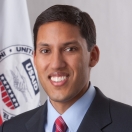
Ed. Note: Cross-posted from the USAID Impact blog.
Eighty kilometers from Kenya’s border with Somalia, the Dadaab Refugee Complex—already the world’s largest refugee camp—has seen on average 1,500 exhausted and starving men, women and children arrive each day. Fleeing from famine that is now gripping a large portion of southern Somalia largely inaccessible to aid workers, thousands of refugees have walked days—or even weeks—to reach help. The United Nations estimates that over 12.4 million people are in urgent need of humanitarian aid, including food, water and medical care, across the drought-stricken eastern Horn of Africa.
Yesterday, I arrived in Dadaab with representatives from across the United States Government, including Dr. Jill Biden, Special Assistant to the President Gayle Smith, Senator Bill Frist and Assistant Secretary of State Eric Schwartz. The trip underscored the commitment of the U.S. Government—the single largest donor in the region—to respond to the immediate crisis with life-saving assistance and investments in long-term solutions to hunger. Ultimately, we know that it is smarter and cheaper to invest in food security than face the consequences of famine and food riots.
In Dadaab, we visited the Dagahaley camp’s reception center, where newly arriving refugees receive a medical screening and three weeks’ worth of food to tide them over until they complete a formal registration process. The USAID-funded rations include high energy biscuits, corn meal, vegetable oil, yellow split peas, salt and sugar. Medical staff weigh the children and measure the circumference of their small arms to determine their nutrition status. Today, the worst-affected regions in Somalia have the highest malnutrition level in the world, with nearly half the population malnourished.
Because the high rates of acute malnutrition make children extremely susceptible to deadly diseases, we are also aggressively pursuing public health interventions, including therapeutic feeding and immunizations.
The Government of Kenya is working closely with the GAVI Alliance to administer pneumococcal vaccines to protect every child from pneumonia at the point of registration.
I met one Somali woman who traveled by donkey cart with her two children for 12 days looking for food. It is hard to believe that she counted among the lucky, as many families have lost children along the way.
It does not have to be this way. With Feed the Future, President Obama’s initiative on food security, we are working with the Kenyan government and smallholder farmers to achieve sustainable, long-term and life-saving agriculture development.
Tomorrow, I will share with you some exciting innovations in agriculture that we saw on our visit to the Kenya Institute for Agriculture—innovations that could help ensure we never face another famine again.
Learn more about the U.S. response to the crisis in the Horn of Africa.
Rajiv Shah is USAID Administrator.


